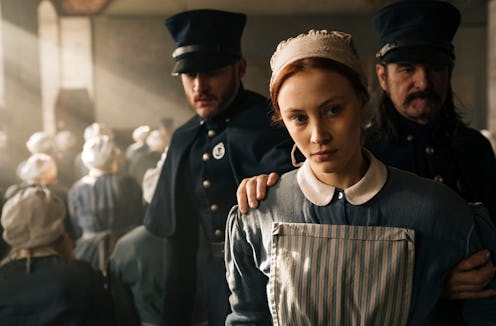Entertainment
Why The Real Grace Marks Is Just As Mysterious As Her Fictional Counterpart

The Netflix thriller Alias Grace is yet another disturbing social commentary piece from author Margaret Atwood, but this is perhaps more troubling than her novel The Handmaid's Tale — now a Hulu hit — because it actually happened. That's right, Grace Marks was a real woman in the 1800s who was sentenced to life in prison after her employer Thomas Kinnear and his housekeeper Nancy Montgomery were found murdered, according to The Hollywood Reporter. Viewers of the miniseries will be wondering — did the real Grace Marks ever get out of prison?
Well, yes, she did. According to the Chicago Tribune, the real Grace Marks was suddenly pardoned for the crime and released after spending 30 years in prison. The Netflix description of Alias Grace claims that her conviction was controversial at the time, and many thought she was "merely an unwitting accessory" to James McDermott, the stable hand who was also tried and convicted for the crime. What became of Marks after she was freed is pretty unclear — The Chicago Tribune reports that reasons for her exoneration are unknown, and so is what exactly happened to her afterward. According to IndieWire, Marks fled from Canada, where the crime occurred, to New York following her release. She assumed the name "Mary Whitney" and then seemingly disappeared from public life altogether.
Her story is certainly in good hands, with Atwood heavily involved and the main showrunners seemingly dedicated to keeping the mystery alive — no one truly knows what Marks' involvement was, and the show is meant to reflect that. "There were so many different, contradictory stories about Grace Marks; nobody actually ever knew whether she had killed anybody or not," Atwood said following a screening of the show at the Toronto International Film Festival, IndieWire reports in the same piece above. "There were four people in the house. Two of them were murdered, the third one was hanged and she was the one left. And she never told."
That's part of what intrigued Atwood, she said. The idea of an unreliable narrator whom you can never really figure out makes for great storytelling. “If I had known the truth [about the murder], I probably wouldn’t have written a book. And if I had known the truth and told it to Sarah [Polley, showrunner], she probably wouldn’t have made this show," Atwood told the audience. "The interesting thing is the way everybody projects their ideas onto Grace. The fact that she had various stories that she told to different audiences… well, that always affects the story that you tell — who the audience is. Does it not?"
Atwood obviously took liberties with the story, as she was not around in the 1840s to observe what truly happened or talk to the real Marks, but the book has kept the true case alive and well in the minds of modern readers. Polley told Variety that it's a book she had grown up with and that has stuck with her. "I first read Alias Grace when I was 17 years old and throughout the last 20 years I have read it over and over, trying to get to the bottom of it," Polley told the magazine. "Grace Marks, as captured by Margaret Atwood, is the most complex, riveting character I have ever read."
It's understandable since the ages-old case has kept even the author of the book and creators of the show guessing, they wouldn't give the series a neat and tidy ending either. The true story of Marks' role in the murder — if she even had one — seemingly disappeared in the 1800s along with her.
Check out Bustle's spooky 'What's Up, Boo?' series and other videos on Facebook and the Bustle app across Apple TV, Roku, and Amazon Fire TV.